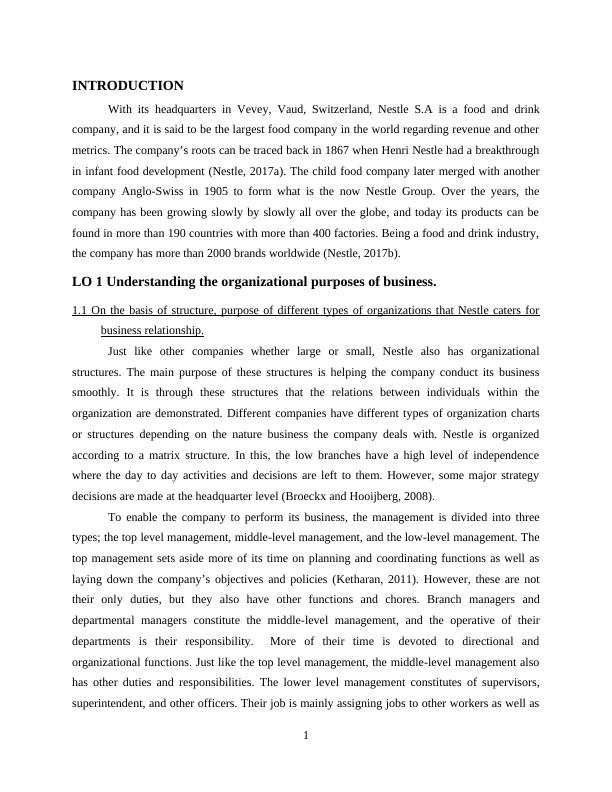Business Environment of Nestle- Doc
Added on 2020-01-28
15 Pages4746 Words76 Views
Business Environment

Table of ContentsINTRODUCTION...........................................................................................................................1LO 1 Understanding the organizational purposes of business.........................................................11.1 On the basis of structure, purpose of different types of organizations that Nestle caters forbusiness relationship...............................................................................................................11.2 Objectives of different stockholders, employees and customers, institutions and agenciesinfluencing operation of organisation in various ways...........................................................21.3 Responsibilities of an organisation and strategies employed to meet them.....................3LO 2 Understanding the nature of the national environment in which business operates...............42.1 Economic systems attempt to allocate resources..............................................................42.2 The impact of fiscal and monetary policy on Nestle business activities..........................42.3 The impact of competition policy and other regulatory mechanisms on Nestle activities.5LO 3 understanding the behaviour of organizations in their market environments. ........63.1 Market structures determine the pricing and output decisions of Nestle.........................63.2 Market forces shape Nestle organizational responses......................................................73.3 The business and cultural environments shape the behaviour of Nestle..........................7LO 4 Assessing the significance of the global factors that shape national business activities........84.1 Significance of international trade to Nestle as a UK business organization...................84.2 Impact of global factors on Nestle as a UK business organization..................................94.3 Impact of policies of the European Union on Nestle as part of the UK businessorganization............................................................................................................................9CONCLUSION..............................................................................................................................10References......................................................................................................................................11


INTRODUCTIONWith its headquarters in Vevey, Vaud, Switzerland, Nestle S.A is a food and drinkcompany, and it is said to be the largest food company in the world regarding revenue and othermetrics. The company’s roots can be traced back in 1867 when Henri Nestle had a breakthroughin infant food development (Nestle, 2017a). The child food company later merged with anothercompany Anglo-Swiss in 1905 to form what is the now Nestle Group. Over the years, thecompany has been growing slowly by slowly all over the globe, and today its products can befound in more than 190 countries with more than 400 factories. Being a food and drink industry,the company has more than 2000 brands worldwide (Nestle, 2017b). LO 1 Understanding the organizational purposes of business.1.1 On the basis of structure, purpose of different types of organizations that Nestle caters forbusiness relationship.Just like other companies whether large or small, Nestle also has organizationalstructures. The main purpose of these structures is helping the company conduct its businesssmoothly. It is through these structures that the relations between individuals within theorganization are demonstrated. Different companies have different types of organization chartsor structures depending on the nature business the company deals with. Nestle is organizedaccording to a matrix structure. In this, the low branches have a high level of independencewhere the day to day activities and decisions are left to them. However, some major strategydecisions are made at the headquarter level (Broeckx and Hooijberg, 2008). To enable the company to perform its business, the management is divided into threetypes; the top level management, middle-level management, and the low-level management. Thetop management sets aside more of its time on planning and coordinating functions as well aslaying down the company’s objectives and policies (Ketharan, 2011). However, these are nottheir only duties, but they also have other functions and chores. Branch managers anddepartmental managers constitute the middle-level management, and the operative of theirdepartments is their responsibility. More of their time is devoted to directional andorganizational functions. Just like the top level management, the middle-level management alsohas other duties and responsibilities. The lower level management constitutes of supervisors,superintendent, and other officers. Their job is mainly assigning jobs to other workers as well as1

End of preview
Want to access all the pages? Upload your documents or become a member.
Related Documents
Significance of Global Factors in Business- Nestlelg...
|14
|5007
|262
Understanding the nature of business: 3 Discussionlg...
|16
|4838
|68
Report on Business Environment of Organizationlg...
|13
|4381
|213
Business Environment | Nestlelg...
|15
|5156
|208
Business Environment Table of contents Introductionlg...
|17
|5657
|160
Report On NESTLE | Different Nature Of Businesslg...
|16
|5193
|199
